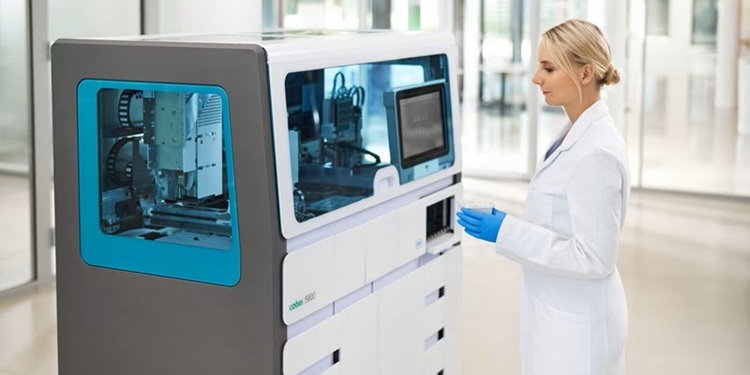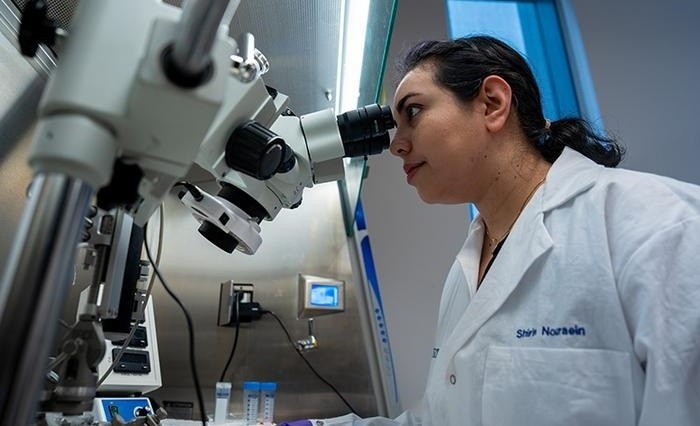Single Test Detects All Existing Strains of H5N1
|
By LabMedica International staff writers Posted on 06 Jun 2012 |
A bird flu diagnostic kit was successfully developed by scientists at a research institute and a hospital in Singapore.
The advanced kit enables doctors to rapidly detect all existing strains of H5N1 viruses in a single test with almost 100% accuracy. This will boost the public healthcare system and will aid pandemic preparedness worldwide against this highly infectious and often lethal disease.
The new H5N1 test kit is more accurately known as the H5N1 real-time Reverse Transcription Polymerase Chain Reaction (RT-PCR) assay. It is the only detection kit currently available on the market that can accurately and rapidly detect all known strains of the H5N1 avian Influenza A virus.
The current gold standard for H5N1 detection recommended by the World Health Organization (WHO; Geneva, Switzerland) is only able to detect three out of the 10 distinct genetic groups (clades 1, 2, and 3). To detect all existing strains of H5N1 with the WHO detection method is not possible.
Codeveloped by Dr. Masafumi Inoue, a senior research scientist and project director of technology development from the Experimental Therapeutics Center (ETC) under the Agency for Science and Technology Research (A*STAR; Singapore) and Dr Timothy Barkham, a senior consultant of Laboratory Medicine from Tan Tock Seng Hospital (TTSH; Singapore), the newly launched H5N1 test kit has been clinically validated by several hospitals in Southeast Asia.
The new test kit is compatible with the previously launched "4-plex" Influenza diagnostic kit. The latter is being used by several regional hospitals in Thailand. Using such multiplex assays enables simultaneous detection and differentiation of the different types of influenza infection in a single test, which will save laboratories time and expense.
"We are excited to be able to contribute to the fight against H5N1 virus with our expertise and know-how. Our technology has greatly simplified and accelerated the process of detection and identification of new H5N1 variants. Such information is especially critical when the virus mutates to become more dangerous, such as in drug resistance." said Dr Inoue.
Related Links:
Agency for Science and Technology Research
Tan Tock Seng Hospital
World Health Organization
The advanced kit enables doctors to rapidly detect all existing strains of H5N1 viruses in a single test with almost 100% accuracy. This will boost the public healthcare system and will aid pandemic preparedness worldwide against this highly infectious and often lethal disease.
The new H5N1 test kit is more accurately known as the H5N1 real-time Reverse Transcription Polymerase Chain Reaction (RT-PCR) assay. It is the only detection kit currently available on the market that can accurately and rapidly detect all known strains of the H5N1 avian Influenza A virus.
The current gold standard for H5N1 detection recommended by the World Health Organization (WHO; Geneva, Switzerland) is only able to detect three out of the 10 distinct genetic groups (clades 1, 2, and 3). To detect all existing strains of H5N1 with the WHO detection method is not possible.
Codeveloped by Dr. Masafumi Inoue, a senior research scientist and project director of technology development from the Experimental Therapeutics Center (ETC) under the Agency for Science and Technology Research (A*STAR; Singapore) and Dr Timothy Barkham, a senior consultant of Laboratory Medicine from Tan Tock Seng Hospital (TTSH; Singapore), the newly launched H5N1 test kit has been clinically validated by several hospitals in Southeast Asia.
The new test kit is compatible with the previously launched "4-plex" Influenza diagnostic kit. The latter is being used by several regional hospitals in Thailand. Using such multiplex assays enables simultaneous detection and differentiation of the different types of influenza infection in a single test, which will save laboratories time and expense.
"We are excited to be able to contribute to the fight against H5N1 virus with our expertise and know-how. Our technology has greatly simplified and accelerated the process of detection and identification of new H5N1 variants. Such information is especially critical when the virus mutates to become more dangerous, such as in drug resistance." said Dr Inoue.
Related Links:
Agency for Science and Technology Research
Tan Tock Seng Hospital
World Health Organization
Latest Microbiology News
- Rapid Diagnostic Test Matches Gold Standard for Sepsis Detection
- Rapid POC Tuberculosis Test Provides Results Within 15 Minutes
- Rapid Assay Identifies Bloodstream Infection Pathogens Directly from Patient Samples
- Blood-Based Molecular Signatures to Enable Rapid EPTB Diagnosis
- 15-Minute Blood Test Diagnoses Life-Threatening Infections in Children
- High-Throughput Enteric Panels Detect Multiple GI Bacterial Infections from Single Stool Swab Sample
- Fast Noninvasive Bedside Test Uses Sugar Fingerprint to Detect Fungal Infections
- Rapid Sepsis Diagnostic Device to Enable Personalized Critical Care for ICU Patients
- Microfluidic Platform Assesses Neutrophil Function in Sepsis Patients
- New Diagnostic Method Confirms Sepsis Infections Earlier
- New Markers Could Predict Risk of Severe Chlamydia Infection
- Portable Spectroscopy Rapidly and Noninvasively Detects Bacterial Species in Vaginal Fluid
- CRISPR-Based Saliva Test Detects Tuberculosis Directly from Sputum
- Urine-Based Assay Diagnoses Common Lung Infection in Immunocompromised People
- Saliva Test Detects Implant-Related Microbial Risks
- New Platform Leverages AI and Quantum Computing to Predict Salmonella Antimicrobial Resistance
Channels
Clinical Chemistry
view channel
Chemical Imaging Probe Could Track and Treat Prostate Cancer
Prostate cancer remains a leading cause of illness and death among men, with many patients eventually developing resistance to standard hormone-blocking therapies. These drugs often lose effectiveness... Read more
Mismatch Between Two Common Kidney Function Tests Indicates Serious Health Problems
Creatinine has long been the standard for measuring kidney filtration, while cystatin C — a protein produced by all human cells — has been recommended as a complementary marker because it is influenced... Read moreMolecular Diagnostics
view channel
Genetic Marker to Help Children with T-Cell Leukemia Avoid Unnecessary Chemotherapy
About 400 children in the UK are diagnosed with acute lymphoblastic leukemia (ALL) each year, with roughly 15% presenting with a more aggressive T-ALL subtype. While the standard approach is a four-week... Read more
Four-Gene Blood Test Rules Out Bacterial Lung Infection
Lower respiratory tract infections (LRTIs) are among the most common reasons for antibiotic prescriptions, yet distinguishing bacterial infections from viral ones remains notoriously difficult.... Read more
New PCR Test Improves Diagnostic Accuracy of Bacterial Vaginosis and Candida Vaginitis
Bacterial vaginosis (BV) impacts approximately 25% of women of reproductive age, while up to 75% of women experience candida vaginitis (CV) at least once in their lifetime. Vaginal symptoms are one of... Read moreHematology
view channel
Platelet Activity Blood Test in Middle Age Could Identify Early Alzheimer’s Risk
Early detection of Alzheimer’s disease remains one of the biggest unmet needs in neurology, particularly because the biological changes underlying the disorder begin decades before memory symptoms appear.... Read more
Microvesicles Measurement Could Detect Vascular Injury in Sickle Cell Disease Patients
Assessing disease severity in sickle cell disease (SCD) remains challenging, especially when trying to predict hemolysis, vascular injury, and risk of complications such as vaso-occlusive crises.... Read more
ADLM’s New Coagulation Testing Guidance to Improve Care for Patients on Blood Thinners
Direct oral anticoagulants (DOACs) are one of the most common types of blood thinners. Patients take them to prevent a host of complications that could arise from blood clotting, including stroke, deep... Read moreImmunology
view channel
New Test Distinguishes Vaccine-Induced False Positives from Active HIV Infection
Since HIV was identified in 1983, more than 91 million people have contracted the virus, and over 44 million have died from related causes. Today, nearly 40 million individuals worldwide live with HIV-1,... Read more
Gene Signature Test Predicts Response to Key Breast Cancer Treatment
DK4/6 inhibitors paired with hormone therapy have become a cornerstone treatment for advanced HR+/HER2– breast cancer, slowing tumor growth by blocking key proteins that drive cell division.... Read more
Chip Captures Cancer Cells from Blood to Help Select Right Breast Cancer Treatment
Ductal carcinoma in situ (DCIS) accounts for about a quarter of all breast cancer cases and generally carries a good prognosis. This non-invasive form of the disease may or may not become life-threatening.... Read morePathology
view channelAI Tool Outperforms Doctors in Spotting Blood Cell Abnormalities
Diagnosing blood disorders depends on recognizing subtle abnormalities in cell size, shape, and structure, yet this process is slow, subjective, and requires years of expert training. Even specialists... Read more
AI Tool Rapidly Analyzes Complex Cancer Images for Personalized Treatment
Complex digital biopsy images that typically take an expert pathologist up to 20 minutes to assess can now be analyzed in about one minute using a new artificial intelligence (AI) tool. The technology... Read moreTechnology
view channel
Artificial Intelligence Model Could Accelerate Rare Disease Diagnosis
Identifying which genetic variants actually cause disease remains one of the biggest challenges in genomic medicine. Each person carries tens of thousands of DNA changes, yet only a few meaningfully alter... Read more
AI Saliva Sensor Enables Early Detection of Head and Neck Cancer
Early detection of head and neck cancer remains difficult because the disease produces few or no symptoms in its earliest stages, and lesions often lie deep within the head or neck, where biopsy or endoscopy... Read moreIndustry
view channel
Abbott Acquires Cancer-Screening Company Exact Sciences
Abbott (Abbott Park, IL, USA) has entered into a definitive agreement to acquire Exact Sciences (Madison, WI, USA), enabling it to enter and lead in fast-growing cancer diagnostics segments.... Read more






















